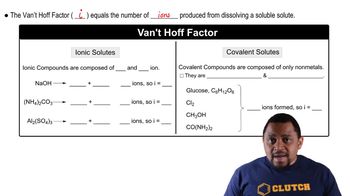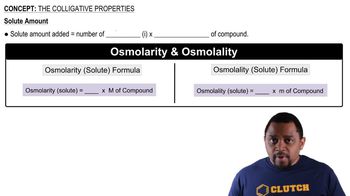Here are the essential concepts you must grasp in order to answer the question correctly.
Osmotic Pressure
Osmotic pressure is the pressure required to prevent the flow of solvent into a solution through a semipermeable membrane. It is directly proportional to the concentration of solute particles in the solution and can be calculated using the formula π = iCRT, where π is the osmotic pressure, i is the van’t Hoff factor, C is the molarity of the solution, R is the ideal gas constant, and T is the temperature in Kelvin.
Recommended video:
van’t Hoff Factor (i)
The van’t Hoff factor (i) represents the number of particles into which a solute dissociates in solution. For ionic compounds like MgCl2, which dissociates into one magnesium ion (Mg²⁺) and two chloride ions (Cl⁻), the van’t Hoff factor is 3. This factor is crucial for calculating colligative properties, including osmotic pressure, as it accounts for the total number of solute particles affecting the solution's behavior.
Recommended video:
Colligative Properties
Colligative properties are properties of solutions that depend on the number of solute particles rather than their identity. These properties include boiling point elevation, freezing point depression, vapor pressure lowering, and osmotic pressure. Understanding colligative properties is essential for predicting how solute concentration affects the physical properties of a solution, which is key in calculating osmotic pressure and the van’t Hoff factor.
Recommended video:
 Verified step by step guidance
Verified step by step guidance

